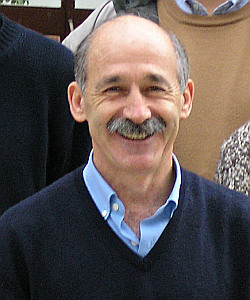 A special lecture took place at the New Forest Campus of the Wessex Institute of Technology on Computational Fluid Dynamics (CFD) Analysis for Aerodynamic Improvement of the Cross Section of the New Bridge over the Fraser River in Vancouver, Canada. The presenter was Professor Santiago Hernandez of the School of Civil Engineering at the University of La Coruña, Spain. Santiago is a well known expert in bridge design who has lectured at WIT on several occasions and is a frequent visitor to the New Forest Campus. He is a member of the Board of Directors of the Institute among others.
A special lecture took place at the New Forest Campus of the Wessex Institute of Technology on Computational Fluid Dynamics (CFD) Analysis for Aerodynamic Improvement of the Cross Section of the New Bridge over the Fraser River in Vancouver, Canada. The presenter was Professor Santiago Hernandez of the School of Civil Engineering at the University of La Coruña, Spain. Santiago is a well known expert in bridge design who has lectured at WIT on several occasions and is a frequent visitor to the New Forest Campus. He is a member of the Board of Directors of the Institute among others.
The structure proposed for Fraser River was a cable stayed cable bridge with two towers and an open type steel deck. The initial design was not optimised aerodynamically due to the need to put forward the proposal at short notice.
A bridge deck, Santiago explained, is subject to the aerodynamic affects such as drag, lift and torque, which can be computed for different angles of attack as is done for the case of aerofoils. In addition, the designer needs to consider the effects of flutter and gusts. These effects are usually studied in a wind tunnel. While the usual aerodynamic coefficients can be identified relatively well, flutter forces are dependent on the bridge movements and velocities and hence need to be carefully studied considering a sectional model of the deck or a model of the full bridge.
A modern challenge is how to obtain the aerodynamic coefficients using computer programmes. Computer predicted coefficients are usually in reasonable agreement with those corresponding to lift and torque as reported by experiments. It is however still early for the methods to take into account fully the complexity of the fluid flow around real and full scale deck which has additional elements such as extended sides for pedestrian walkways, railings, barriers etc.
In spite of that CFD can be seen as a powerful tool for preliminary design; a process during which the geometry of the bridge can be improved before checking the final design in the wind tunnel.
The aim of the project under Santiago was to compute the actual aerodynamic coefficients for a real deck. They attempted to carry out this work by using a very dense mesh, able to reproduce boundary layers in the critical part of the bridge section.
It was found that the extra parts of the bridge structure such as barriers, hand rails, etc would significantly alter the aerodynamic behaviour of the bridge deck. Up to a point however variations showing the importance of these components can be studied using CFD packages.
After a series of studies, it was decided that the best design for the deck was close to the original design and that the basic aerodynamic coefficients (drag, lift and torque) obtained from experiments and computer solutions were in close agreement.
The feedback from Santiago’s research group to the designers was that the deck should be closed (ie becoming a box type structure) rather than open at the bottom, to improve the aerodynamic behaviour of the bridge. Unfortunately this advice was ignored and the design was not successful in winning the competition.
Santiago made the following recommendations for a better understanding of the deck response of similar bridges under wind flow, ie that two studies should be carried out as a minimum, ie:
- A comprehensive series of wind tunnel tests of a sectional model
- A boundary layer wind tunnel testing comprising a full bridge model taking into account the topography as well as other existing structures surrounding the bridge.

 Wessex Institute
Wessex Institute